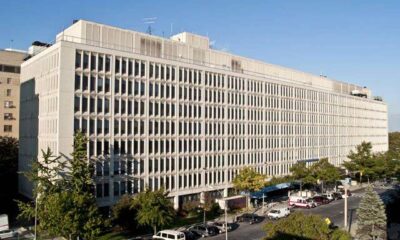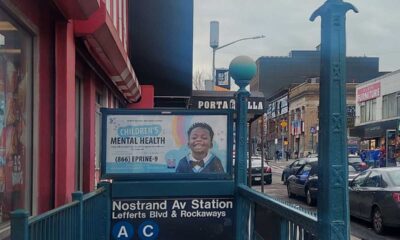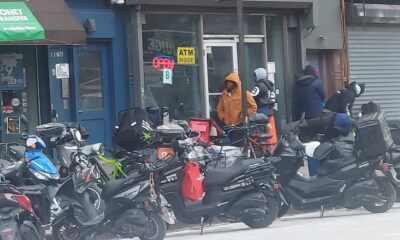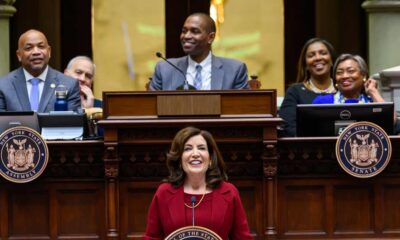Crime
National Guard at NYC Subway Stations – the response
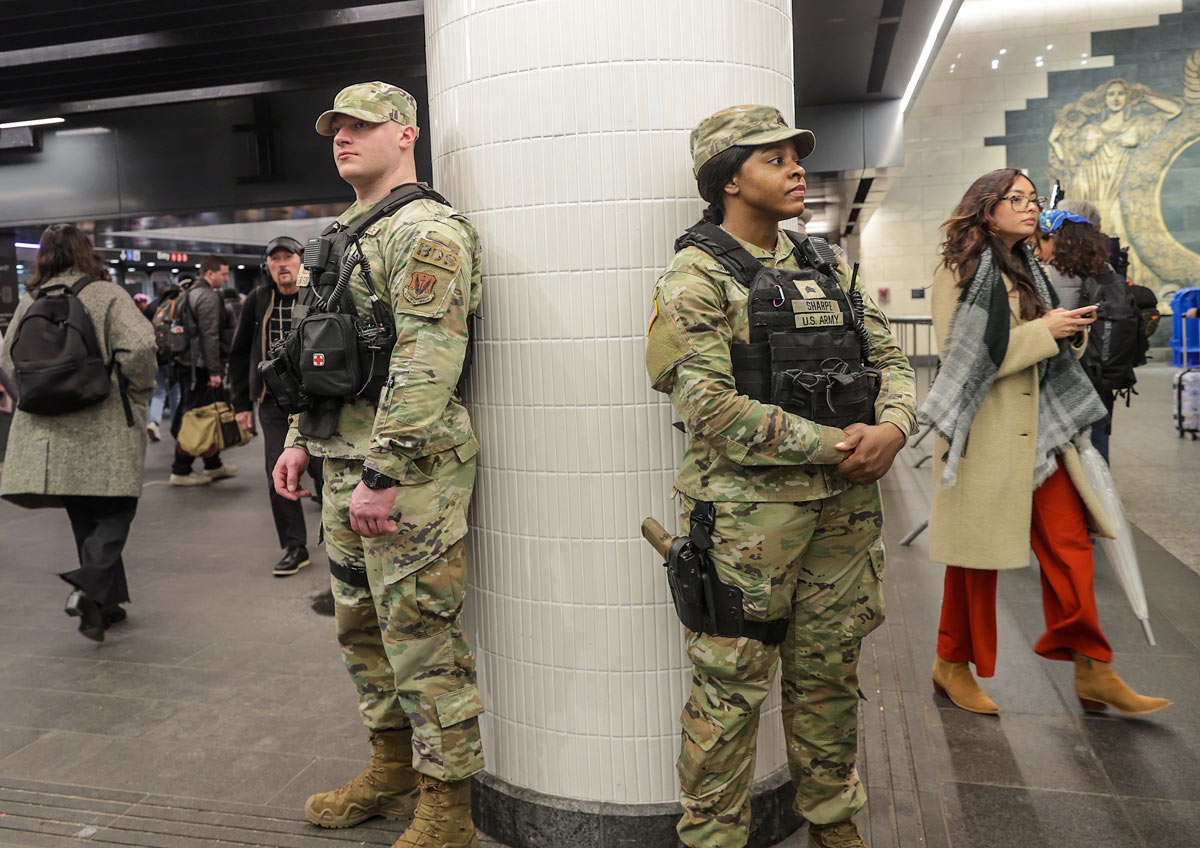
By Nayaba Arinde
Editor at Large
This is not a drill, the nation’s organized militia – the National Guards are now stationed at several New York City subway stations.
“At least they don’t have their long guns anymore,” a male commuter repeated several times as he walked past two National Guardsmen on Tuesday, March 11, at the Fulton Street subway hub at John Street in Lower Manhattan. The two military men ignored the heckling. An NYPD police sergeant monitored the scene, as he directed unsuspecting riders to a table where two police officers dove into their bags.
Lead balloons get floated to see if they land, or they wait for the thud.
Last week, Gov Hochul sent 750 National Guard members to check commuters’ bags at turnstiles in major New York City subway hubs like 34th Street and Times Square.
The National Guard are presently deployed on Joint Task Force Empire Shield. Now they are subjected to fall under NYPD officers’ jurisdiction, who have already been rummaging through riders’ bags for more than 15 years.
It is a common sight. But now Hochul has added 250 members from the New York State Police and the MTA Police Department, who can call folk to the side to dive into their personal bags.
In response to the recent rash of violence on the subway system – shootings, beatings, stabbings – had Hochul deploying the National Guard.
“Since taking office, I have been laser-focused on driving down subway crime and protecting New Yorkers,” Governor Hochul said. “My five-point plan will rid our subways of violent offenders and protect all commuters and transit workers.
I am sending a message to all New Yorkers: I will not stop working to keep you safe and restore your peace of mind whenever you walk through those turnstiles.”
National Guard members with M4 carbines on the New York City transit system was enough to create a public brouhaha that had Gov. Hochul rescind her call to have the soldiers be strapped with their automatic firing, body armor-piercing military assault rifles.
Hochul said, “As soon as I saw the first photo of them carrying a long gun, I said, I don’t think that’s necessary…This is more akin to just being there in a supportive role, letting people know if they need help there’s extra people there.”
“It means you have lost control of the city,” Brooklyn activist Caleef Cousar told Our Time Press. “If it can happen in New York, it can happen anywhere. This a test run, because what’s going on underground, will come overground.
What if they bring the National Guard to regular everyday life situations? There’s no way in the world, with subway incidents increasing, and even with unlimited unvetted migrants – they do not have a counter-plan. Is this it?
They have now brought the National Guard to a situation that the City should be capable of handling.”
But, retired NYPD captain Mayor Eric Adams insisted, “The presence of a uniform makes people feel better, and if the National Guards or the state police want to add to that presence, I applaud that.”
“It’s another form of stop and frisk,” retired NYPD detective Graham Weatherspoon told Our Time Press. “I don’t know why they are doing bag checks. Most people committing crimes are not carrying bags. So you are going to arbitrarily do a stop and frisk – predicated on what?”
Those carrying weapons are prone to carry them in waistbands, not backpacks.
After 9/11 under the auspices of the Empire Shield joint task force, the National Guard has been a common sight in places like Penn Station, Grand Central Station, or even now the Oculus at the World Trade Center.
“The initial decision by Gov. Hochul to send the National Guard and MTA Police throughout the subway system was clearly an over-reaction,” retired detective Marquez Claxton told Our Time Press.
“Although Mayor Adams’ 2022 Subway Safety Plan emphasized omnipresence of law enforcement, it never indicated expanding the use of the National Guard with long guns with the MTA Police conducting bag searches next to them, throughout the entire system. Gov. Hochul made the decision that rather than providing State funding to support an increased NYPD presence throughout the system, she would utilize the State’s personnel and expand their presence from the 2022 levels when they were only assigned to the 4 major commuter railroad hubs (Penn Station, Grand Central Station, Atlantic Terminal, Sutphin-Archer/Jamaica Station).”
Black Law Enforcement Alliance co-founder Claxton said, “Given NYC’s history of law enforcement constitutional infringements, these well intended actions may increase anxiety rather than actually allaying fears or addressing the issue of ‘feeling’ safe.
A more prudent and proven successful approach would be for the State to increase funding for the original Subway Safety Plan which was more holistic and resulted in dramatic crime decreases once the NYPD was able to fund the overtime associated with shifting above-ground resources to the subway system. A police omnipresence plan has to be organized and managed separate and independent of any military support action.”
A City Hall spokesperson told Our Time Press this week: “Under the Adams administration, overall crime is down across the city, and transit crime was down 15 percent in February. Governor Hochul has been a true partner in keeping New Yorkers safe on our subways…We continue to surge NYPD officers into the system.”
The TWU, while accepting the increased law enforcement presence, slammed Manhattan DA Alvin Bragg, and MTA Jan Lieber as being soft on crime. TWU Local 100 President Richard Davis said, ”Most of the people that’s being arrested have priors.
If you look at their record, they have multiple, multiple arrests.. multiple times have been in jail, and the courtroom is like a revolving door. They come right back out on the street.”
There have been three murders on the subways this year. Last month subway station agent Noreen Mallory was repeatedly punched in the face by a man on the 4/5 train Wall Street subway platform.
Last month C train conductor Alton Scott received 24 stitches after being slashed in the throat after 3 am at the Rockaway Avenue subway station.
A spokesperson for DA Bragg told Our Time Press in a statement: “Manhattan is the only borough in the city where transit crime is down, yet ironically the only local elected official named at today’s press conference was Alvin Bragg.
We make charging decisions based on facts and evidence, and anyone who jeopardizes the safety of passengers or transit workers is held accountable. The continued decrease in transit crime throughout the borough is the result of our comprehensive strategy and close collaboration with our law enforcement partners.
We care deeply about the safety of TWU members. We have offered and continue to welcome a meeting with TWU leadership, so we can have a productive conversation with real solutions that will hold up in court.”
MTA Chairman Janno Lieber said, “My view is the NYPD is doing a hell of a job in the New York subway system…The Governor has brought additional resources. The MTA has the NYPD’s full confidence.”
“I would love to have that state trooper standing there,” Mayor Adams said. “I think their uniforms are cool as hell. Having them being there, standing in the subway system. People like seeing it.”
New York Civil Liberties Union executive director Donna Lieberman said, “Deploying military personnel to the subways will not make New Yorkers feel safe; it will, unfortunately, create a perfect storm for tension, escalation, and further criminalization of Black and Brown New Yorkers.”
“It’s giving the people a false sense of security. This is an image of protection. They are not deterring crime,” retired detective Weatherspoon told Our Time Press. “You can’t fire a long gun in a crowded station. You can’t fire an AR15 in the subway that’s going to go through a person, and hit a few other people.”
Saying that it was more PR, than practical, Weatherspoon said it was also “abject stupidity.”
The immediate public outcry brought a reversal to that decision.
“What is needed is adequate staffing of NewYork Transit police. The way you bring crime down in the subway is by having police officers in the subway, and the transit bureau.”
Hochul’s office nor the NYPD did not respond to Our Time Press inquiries by press time.
Weatherspoon added, “The MTA eliminated token booths in areas where there should be an agent. They have cameras, but they don’t do a damn thing when you’re being robbed, had your head cracked in, or you’re pushed on the tracks.
I ride the subway, why are there E-bikes, and gasoline-powered scooters on the subway that can burst into flames? Used to be you couldn’t get a bicycle on the train. What is going on?”
Cousar continued, “It’s optics. They’ve already got scare tactics in place. But it adds to the fear factor under which our communities are used to.
You are disarming the citizens physically and mentally. We are used to seeing the National Guard helping out in natural disasters, hurricanes, floods, and civil unrest – not going through handbags in the subway. Wait till it gets hot – like 80 degrees day after day. But, whatever happens in New York, happens in New Jersey, and Philly.”
“How many surges of law enforcement into the subway will satisfy the political desire of city and state leaders to address riders’ fears being fanned by those same leaders? This is the fifth or sixth in recent years, and even in response to real concerns and crimes, it remains unsustainable,” said Public Advocate Jumaane Williams.
“Militarizing the subway with the National Guard and suggesting a wholesale ban on individuals from accessing public transportation are dangerous misuses of resources which could be better spent addressing these issues at their root.
It’s one thing to have conductors announce increased police presence on the platform. It’s another entirely to further criminalize the public on public transit while neglecting the real improvements these resources could be devoted to, like fixing the subway itself.”


